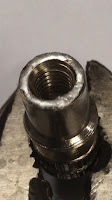Traditionally this is the last post of the year. Last year I wrote that I hoped not to be infected by covid. Unfortunately it caught us as family. The downside of it all is that I'm not in the mood to do something with my radio hobby. The few things I did during quarantine was cleaning the shack and repairing the main 230V switches. The safety ground issue is still something I'm not satisfied about and it keeps playing in my mind. I have to sort things out.
This year started with my participation in the True Blue DXers Club Ultra Marathon. Many HAMs thought that it was only for those that did only SSB and CW and no FT8. It is not the case, everyone can participate and it is not forbidden to do FT8 as well. But of course only SSB/CW (depending section) QSOs count! So far, I hoped for some more SSB QSOs. Unfortunately time didn't allow me to make as many as I did FT8 QSOs. It is simply a matter of how easy you can make a FT8 QSO and how difficult and time consuming it is to make a SSB QSO. Besides that, FT8 is much more suitable to work remote from the living room while doing other things at the same time. I made over 2000 SSB QSOs this year according to the TBDXC marathon score server.
Of course I continued with DXing, something I love to do most on HF radio. Especially the 60m and 6m had my interest this year. I worked 8 new 60m DXCC this year but heard (seen) at least 16 new DXCC. It frustrates me sometimes I didn't work everything. Sometimes I was just too late, or it was just a too busy pile-up. In the end I probabely get another chance another year. What can I tell, I worked 177 DXCC on 60m till now, I think that is not bad at all. The ES season took off really well in April and I did surprisingly well I think with 20 new band DXCC giving me a total of 103 DXCC on 6m. 4m DX was rather disappointing, I only worked 2 new ones. What can I say, I shouldn't complain I think. There is always a next season...
Personally I think my most important post this year was about the discovery of the WW2 paraset (spy radio) manual. After my first post about it in March I got many replies and requests. The story and manual is published at the cryptomuseum and after some research it was decided to give the actual "paracette" an own page. The story was also published in our local amateurradio magazine "Hunsotron" and in the national VERON magazine "Electron". After all it is an unique document, the only one known in the world.
I did some antenna experimenting as well. Changing the magnetic loop with some additional features and did some modifications to my all band vertical. Unfortunately the 5 band quad is still an idea. Will I ever build it? I really like to tinker with antennas to improve the station. Although I have still a lot to learn. So many ideas and not enough time...
And now my goals for 2022. When I look back at my goals for this past year I actually did well. Except may be not building a 5 band quad. I had a lot of ideas for next year. One of these was a 2022 challenge idea. Unfortunately I had not foreseen what would happen this month. I'm sorry but at this moment I partly lost my interest in the radiohobby at this moment of time. I really can't think of any goals for next year. So I keep it simple, no goals.
However, my dear blog readers, time and life goes on. I wish you and yours all a prosperous 2022.





















































